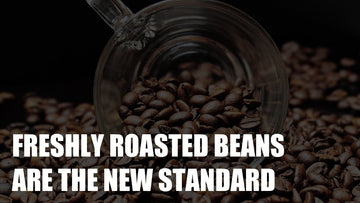Freshly roasted coffee can exhibit a slightly green taste, akin to being undercooked. But fear not! Within those initial days, this characteristic dissipates, paving the way for the true flavours to emerge.
Supermarkets, on the other hand, often miss the mark entirely. Rather than offering recently roasted coffee, it's not uncommon for their stock to have languished for months before reaching your shelf. Navigating the complexities of the supply chain means that ensuring truly fresh coffee in-store becomes a logistical challenge.
Understanding Degassing.
During the roasting process, coffee beans undergo a transformation where a significant portion of their organic matter is expelled as gas. However, even after roasting, some gas remains trapped within the beans. This residual gas can take anywhere from a few days to several weeks or even months to fully dissipate, although the rate notably slows after the initial week. It's within this timeframe that coffee reaches its peak flavour profile.
When water comes into contact with coffee grounds, it prompts the release of internal gases, a phenomenon observable as bubbles rising to the surface. Professional baristas leverage this knowledge when preparing coffee, allowing the grounds to "bloom" by briefly saturating them with water before continuing the brewing process.
As a fervent aficionado of the French press method, I've perfected my technique to maximise the bloom. Rather than hastily pouring water over the grounds, I first moisten them to induce blooming. Witnessing the grounds swell and form a delicate foam reveals the presence of released gases—a telltale sign of freshness. Older coffee, lacking this visible foam, unmistakably pales in comparison.
The Power Of One Way Valves.
In the realm of coffee packaging, one simple feature can elevate a good bag to greatness: the one-way valve. Nestled somewhere near the bag's apex, this circular cut-out serves a vital purpose—it allows carbon dioxide (CO2) to escape while steadfastly keeping oxygen at bay. Without this ingenious valve, the bag would swell ominously, risking a potential pop!
Take a stroll down the aisles of your local grocery store, and you may encounter ground coffees resembling bricks with their sharp edges. It's a visual cue worth heeding: a bag resembling a brick is likely a coffee not worth your precious time. If a coffee appears vacuum-sealed yet maintains such rigid form, it's a glaring sign that the beans never had the chance to degas within the confines of the package. Instead, they may have languished for weeks, exposed to the unrelenting embrace of open air before being hastily packaged.
Battling Oxygen Exposure.
For coffee to maintain its peak flavour, it must be shielded from the harmful effects of open air and oxygen. Exposed to these elements, coffee undergoes oxidation, resulting in a dulling of flavours and a diminished aroma.
At our establishment, we employ one-way valves adept at repelling oxygen, ensuring your coffee stays fresher for longer. Moreover, our bags boast resealable features, affording you the flexibility to seal them shut whenever necessary. Additionally, consider investing in coffee canisters, particularly those equipped with a vacuum seal mechanism, for optimal preservation.
Remember, the key to prolonging your coffee's freshness lies in diligent sealing whenever it's not in use. By adopting these practices, you'll safeguard your coffee's flavour integrity and elevate your brewing experience to new heights.
Parting Thoughts.
Embarking on the journey of savouring fresh coffee may require a tad more patience and foresight, yet the rewards are unequivocally worth it! As you delve into this realm, prepare to awaken your senses to a symphony of flavours and aromas previously unnoticed, unveiling an entirely novel dimension of coffee appreciation.
The question remains: when will you indulge in your freshly acquired coffee? While the allure of immediate gratification is undeniable, we advocate for exercising restraint and allowing just a few days for your brew to reach its zenith.
However, if the anticipation becomes too much to bear, here's a nifty trick: grind a small portion of your coffee and let it rest for a few hours. Ground coffee expels gases more rapidly due to increased surface area, expediting the degassing process. It's this principle that also underscores the importance of consuming pre-ground coffee sooner rather than later. We highly recommend grinding your coffee as you need it, and store the beans correctly.






